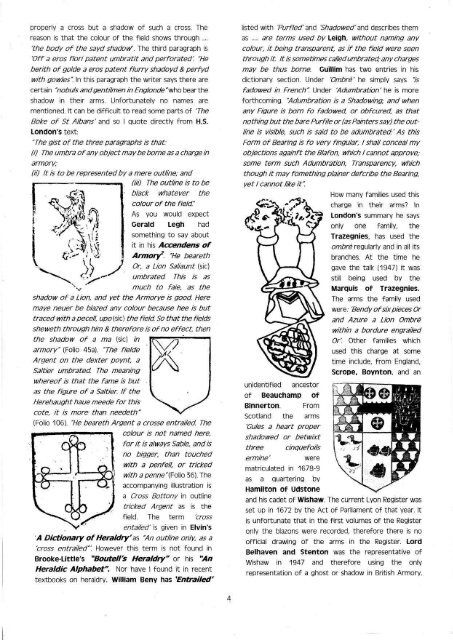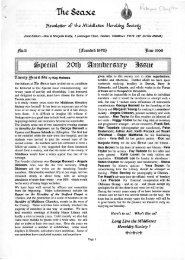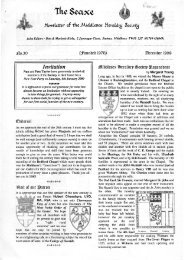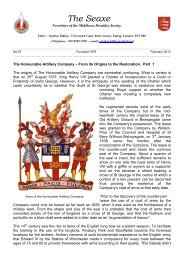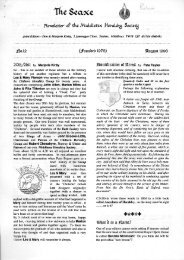The Seaxe - Middlesex Heraldry Society
The Seaxe - Middlesex Heraldry Society
The Seaxe - Middlesex Heraldry Society
Create successful ePaper yourself
Turn your PDF publications into a flip-book with our unique Google optimized e-Paper software.
properly a cross but a shadow of such a cross. <strong>The</strong><br />
reason is that the colour of the field shows through ....<br />
'the body of the sayd shadow. <strong>The</strong> third paragraph is<br />
'Off a cros flori patent umbratit and perforated'. "He<br />
berith of go/de a cros patent flurry shadoyd & perfyd<br />
with gowles". In this paragraph the writer says there are<br />
certain "nobuls and gentilmen in Englonde "who bear the<br />
shadow in their arms. Unfortunately no names are<br />
mentioned. It can be difficult to read some parts of <strong>The</strong><br />
Boke of St Albans' and so I quote directly from H.S.<br />
London's text<br />
'<strong>The</strong> gist of the three paragraphs is that:<br />
(i) <strong>The</strong> umbra of any object may be borne as a charge in<br />
armory;<br />
(ii) It is to be represented by a mere outline; and<br />
(iii) <strong>The</strong> outline is to be<br />
black whatever the<br />
colour of the field"<br />
As you would expect<br />
Gerald Legh had<br />
something to say about<br />
it in his Accendens of<br />
Armory 2 . "He beareth<br />
Or, a Lion Saliaunt (sic)<br />
umbrated. This is as<br />
much to faie, as the<br />
shadow of a Lion, and yet the Armorye is good. Here<br />
maye neuer be blazed any colour because hee is but<br />
traced with a pecell, upo (sic) the field. So that the fields<br />
sheweth through him & therefore is of no effect, then<br />
the shadow of a ma (sic) in<br />
armory" (Folio 45a). "<strong>The</strong> fie/de<br />
Argent on the dexter poynt, a<br />
Saltier umbrated. <strong>The</strong> meaning<br />
whereof is that the fame is but<br />
as the figure of a Saltier. If the<br />
Herehaught haue meede for this<br />
cote, it is more than needeth"<br />
(Folio 106). "He beareth Argent a crosse entrai/ed. <strong>The</strong><br />
co/our is not named here,<br />
for it is always Sable, and is<br />
no bigger, than touched<br />
with a penfell, or tricked<br />
with a penne"(Folio 36). <strong>The</strong><br />
accompanying illustration is<br />
a Cross Bottony in outline<br />
tricked Argent as is the<br />
field. <strong>The</strong> term 'cross<br />
entailed' is given in Elvin's<br />
A Dictionary of <strong>Heraldry</strong>' as "An outline only, as a<br />
'cross entrailed"'. However this term is not found in<br />
Brooke-Little's "BoutelI's <strong>Heraldry</strong>" or his "An<br />
Heraldic Alphabet". Nor have I found it in recent<br />
textbooks on heraldry. William Beny has 'Entrailed'<br />
4<br />
listed with 'Purfled' and 'Shadowed' and describes them<br />
as are terms used by Leigh, without naming any<br />
colour, it being transparent, as if the field were seen<br />
through it. It is sometimes called umbrated; any charges<br />
may be thus borne. Guillim has two entries in his<br />
dictionary section. Under 'Ombre' he simply says "is<br />
fadowed in French". Under 'Adumbration' he is more<br />
forthcoming. "Adumbration is a Shadowing; and when<br />
any Figure is born fo fadowed, or obfcured, as that<br />
nothing but the bare Purfile or (as Painters say) the outline<br />
is visible, such is said to be adumbrated:' As this<br />
Form of Bearing is fo very fingular, I shall conceal my<br />
objections againft the Blafon, which I cannot approve;<br />
some term such Adumbration, Transparency, which<br />
though it may fomething plainer defcribe the Bearing,<br />
yet I cannot like it".<br />
How many families used this<br />
charge in their arms? In<br />
London's summary he says<br />
only one family, the<br />
Trazegnies, has used the<br />
ombre regularly and in all its<br />
branches. At the time he<br />
gave the talk (1947) it was<br />
still being used by the<br />
Marquis of Trazegnies.<br />
<strong>The</strong> arms the family used<br />
were: 'Bendy of six pieces Or<br />
and Azure a Lion ombre<br />
within a bordure engrailed<br />
Or'. Other families which<br />
used this charge at some<br />
time include, from England,<br />
Scrope, Boynton, and an<br />
unidentified ancestor<br />
of Beauchamp of<br />
Binnerton. From<br />
Scotland the arms<br />
'Gules a heart proper<br />
shadowed or betwixt<br />
three cinquefoils<br />
ermine' were<br />
matriculated in 1678-9<br />
as a quartering by<br />
Hamilton of Udstone<br />
and his cadet of Wishaw. <strong>The</strong> current Lyon Register was<br />
set up in 1672 by the Act of Parliament of that year. It<br />
is unfortunate that in the first volumes of the Register<br />
only the blazons were recorded, therefore there is no<br />
official drawing of the arms in the Register. Lord<br />
Belhaven and Stenton was the representative of<br />
Wishaw in 1947 and therefore using the only<br />
representation of a ghost or shadow in British Armory.


